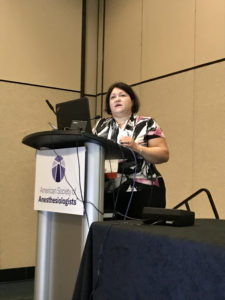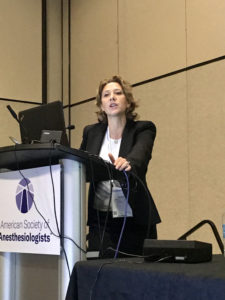In January 2019, the Enhanced Recovery After Surgery (ERAS) Society and the European Society of Thoracic Surgeons (ESTS) published guidelines for enhanced recovery after lung surgery. It was a much-needed set of principles, according to Adriana Oprea, M.D., Associate Professor of Anesthesiology at the Yale School of Medicine, and Wanda Popescu, M.D., Professor of Anesthesiology and Director of the Thoracic and Vascular Anesthesia Section at the Yale School of Medicine. The two comprised Saturday’s panel “ERAS for Thoracic Surgery: The Past, the Present and the Future.”

Adriana Oprea, M.D.
Thoracic surgery, said Dr. Oprea, has a 27% risk of complications – higher than most surgeries because of the invasiveness of the procedure as well as the likelihood of dealing with older patients. By implementing ERAS protocols, a medical team can improve quality of care, safety, patient satisfaction and costs.
Part of this implementation includes treating surgery as a marathon rather than a sprint, said Dr. Oprea. Physicians should actively engage a patient in surgery preparations in both the preoperative and admissions phases, including focusing on smoking cessation and an exercise regimen. It’s also important to look for preoperative iron deficiency anemia, to consider carbohydrate loading and to avoid preoperative sedatives.
Once it’s go-time and a patient is on the table, the focus shifts. Dr. Popescu was one of the authors of the 2019 guidelines for enhanced recovery after lung surgery.
“Postoperative complications in lung surgery are quite numerous and quite high,” said. Dr. Popescu. “And a lot of these complications – in part at least – do have a lot to do with what we do in the operating room.”
One way to work to prevent pulmonary complications is by focusing on protective lung ventilation strategies. When it comes to one-lung ventilation, said Dr. Popescu, it’s critical to focus on what happens in the lung that isn’t ventilated. When the non-ventilated lung blood flow goes down, it later goes right back up. This can increase the likelihood of reperfusion injury.

Wanda Popescu, M.D.
“If you’re going to ventilate with 100%,” said Dr. Popescu, “What are you doing? You’re adding fuel to the fire.” This comes with additional oxidation stress. In 2019, Dr. Popescu said there is now discussion about only ventilating for one to two hours to decrease oxidation stress, since there is a clear correlation between that stress and postoperative pulmonary complications.
This year is also bringing in discussions about fluid management in lung surgery. Dr. Popescu said a large randomized controlled trial about fluid management did not exist until a study by Myles in 2018 that looked at the difference in restrictive versus liberal fluid therapy for major abdominal surgery. The recommendation is now that very restrictive or liberal fluid regimes should be avoided in favor of euvolemia.
The final intraoperative tactic Dr. Popescu focused on was the consideration of different options for pain control in thoracic surgery.
“Pain is rather complicated in thoracic surgery because it has so many different pathways,” she said. There are multiple ways to address pain in lung surgeries, including systemic opioids, epidural opioids, local anesthetics and NSAIDS. And while opioids have many pros, there are cons that must be factored in, too.
By combining various classes of analgesics, it’s possible to manage a patient’s pain while decreasing some of the negatives associated with opioids.
The Cochrane Library recommends that anesthesiologists use paravertebral blocks versus thoracic epidurals when possible, given that paravertebral blocks are just as effective but associated with fewer complications. (Dr. Popescu noted that thoracic epidurals may still be called for.) New data is emerging about plane blocks, PEC I and PEC II blocks as well as serratus anterior blocks.
Dr. Popescu also recommended considering liposomal bupivacaine, citing a steady release of bupivacaine over time and a better safety profile, although she said the liposomal form costs around $300 in the United States, where traditional bupivacaine costs closer to $3.
Return to Archive Index